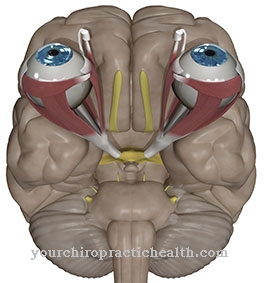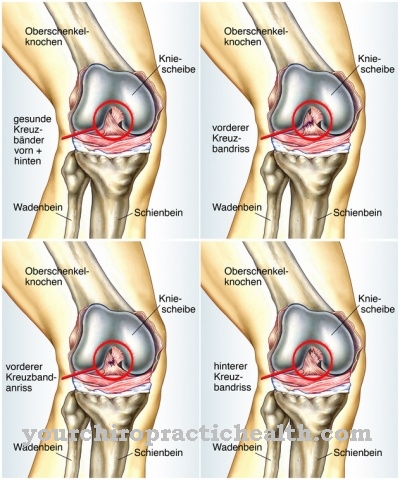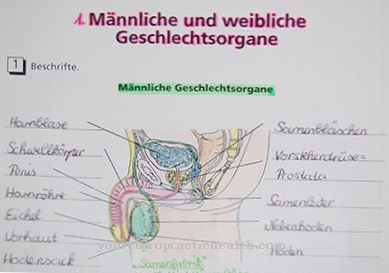The Subclavian steal syndrome describes a temporary or chronic partial or complete occlusion of the arteries, which are responsible for the blood flow to the brain and the upper extremities.
What is subclavian steal syndrome?

© peterschreiber.media - stock.adobe.com
In which Subclavian steal syndrome it is a reduced blood flow to the arteries, which are responsible for the blood supply to the upper extremities and the brain.
On the left side, the upper area of the shoulder girdle artery, the so-called subclavian artery, is affected. This case occurs more often. On the right side, there are circulatory disorders in the brachiocephalic trunk. The circulatory disorder is caused by temporary occlusions or severe narrowing of the artery.
This can lead to serious illnesses, which is why subclavian steal syndrome must be treated. At best, a healthy lifestyle prevents the diseases that lead to subclavian steal syndrome.
causes
When it comes to one Subclavian steal syndrome comes, this can have several causes. On the one hand, subclavian steal syndrome can be caused by arteriosclerosis.
Atherosclerosis describes a disease in which there is deposits of blood lipids, connective tissue, thrombi and small amounts of calcium in the arteries. In the vernacular, arteriosclerosis is therefore also known as hardening of the arteries.
Another possible cause of subclavian steal syndrome is Takayasu arteritis, an autoimmune disease that causes inflammation of the aorta, which in the worst case results in destruction of the vessel walls.
Symptoms, ailments & signs
Subclavian steal syndrome is characterized by both neurological and arm-stressed symptoms. The entire symptomatology, however, depends on the extent of the decrease in blood flow through the arteries supplying the brain. There are asymptomatic, seizure-like and continuous forms of the disease.
If the flow dynamics in the brachial artery are normal, no symptoms occur. In cases of short-term interruption of the blood flow, there are sudden symptoms that begin with arm movements.In some of the patients, the blood flow through the arteries supplying the brain is permanently reduced. This leads to chronic complaints.
The neurological symptoms are characterized by attacks of dizziness and attacks of unconsciousness, among other things. Sudden falls while fully conscious are also possible. There is a loss of tone in the lower extremities. As part of the neurological deficits, visual disturbances, noises in the ears, sensory disturbances, coordination disturbances in movement or speech and swallowing disturbances are also observed.
In addition to the neurological deficits, there are often symptoms that emphasize the arm, which usually only appear on one side. These affect the arms and manifest themselves there in the form of paresthesia (tingling, numbness), paleness, feelings of cold and pain. Usually only a part of the symptoms occurs. Only in severe forms of the disease does the patient suffer permanently from all symptoms. The complaints often increase with arm movements.
Diagnosis & course
If that Subclavian steal syndrome If the blood supply is briefly interrupted, asymptomatic abnormalities usually occur, which make a diagnosis of subclavian steal syndrome more difficult.
If, however, a permanent subclavian steal syndrome occurs, it is mainly neurological deficits such as sudden dizziness to fainting, sensory disorders, visual disturbances and minor strokes that reinforce the suspicion of subclavian steal syndrome.
There is also a slight tingling or itching up to severe pain in the arms. The arms also often lose color and feel cold. If these symptoms occur and subclavian steal syndrome is suspected, a doctor can diagnose subclavian steal syndrome by taking a comprehensive medical history followed by an extensive physical examination.
Blood pressure and pulse as well as flow noises provide initial clues. Subclavian steal syndrome can then be clearly identified using imaging techniques such as duplex sonography or angiography. If subclavian steal syndrome is left untreated, strokes, from minor to severe, which can be fatal.
Even if failure to treat subclavian steal syndrome does not result in death, severe damage and disabilities are possible if the brain is not supplied with blood and therefore with oxygen for too long as a result of the circulatory disorders. At the slightest signs of subclavian steal syndrome, a doctor should be consulted so that he can either rule out subclavian steal syndrome or start appropriate treatment immediately.
Complications
In the worst case scenario, subclavian steal syndrome can lead to death. However, this case only occurs if the disease is not treated. Those affected primarily suffer from severe dizziness and continue to be unconscious. There are noises in the ears and also various visual disturbances, which, however, only occur temporarily.
Sensitivity disorders and paralysis can also occur in subclavian steal syndrome and have a very negative effect on the patient's quality of life. There is also pain and paleness in the person concerned. Those affected with subclavian steal syndrome often freeze and also suffer from tingling in the extremities. If the disease is not treated in time, the internal organs can also be damaged.
The syndrome may also reduce the patient's life expectancy. There are usually no particular complications involved in treating this condition. With the help of surgical interventions, the symptoms can be alleviated. Subclavian steal syndrome usually also requires subsequent treatment with medication. Furthermore, a healthy lifestyle has a very positive effect on the disease and can prevent further symptoms.
When should you go to the doctor?
In the case of subclavian steal syndrome, the person affected is in any case dependent on a visit to a doctor. This disease cannot heal itself, and if left untreated, the symptoms worsen significantly and, in the worst case, can even lead to the death of the person affected. A doctor should therefore be consulted at the first symptoms and signs of subclavian steal syndrome in order to prevent further complications.
A doctor should be consulted if the person concerned suddenly has severe dizziness. It can even lead to a loss of consciousness. Furthermore, disturbances of the sensitivity or discomfort when swallowing indicate the subclavian steal syndrome and should be examined by a doctor immediately. Very paleness or a permanent feeling of cold also often indicate this disease. Many sufferers also experience sudden visual problems.
Subclavian steal syndrome should usually be treated immediately by an emergency doctor or in a hospital. In some cases, the person may also see a general practitioner or cardiologist first. Whether the subclavian steal syndrome will lead to a reduced life expectancy cannot be universally predicted.
Treatment & Therapy
A Subclavian steal syndrome is treated depending on the respective concomitant symptoms. A slight constriction of the vessels can be remedied by a so-called angioplasty. The vessels are widened again using so-called balloon catheters, which are often inserted into the vessels via the groin.
In addition, so-called stents are often placed in the affected vessel. These stretchable metal or plastic tubes also ensure that the lock is removed and the blood vessel can be supplied with sufficient blood again. In the case of severe vascular constrictions, on the other hand, surgical intervention often has to be performed in which a bypass is placed. This is an artificial bypassing of the vascular segment in which the vascular narrowing is present.
prevention
To one Subclavian steal syndrome To prevent this, all diseases that can lead to arterial occlusion must be prevented.
A healthy diet and lifestyle are particularly effective. Smoking, in particular, can block arteries, disrupt or interrupt blood flow and lead to subclavian steal syndrome.
Other risk factors that favor subclavian steal syndrome and should therefore be avoided are an excessive fat diet and obesity, high blood pressure and high cholesterol levels. A low-fat diet with sufficient exercise is therefore also a good way to prevent subclavian steal syndrome.
Aftercare
Since the subclavian steal syndrome is a congenital and therefore genetically determined disease, it usually cannot heal itself. Those affected are therefore dependent on the examination and treatment by a doctor. The measures and the options for follow-up care are usually significantly limited.
An early diagnosis can prevent further symptoms and complications from occurring. If the person concerned or the parents want to have children, genetic testing and counseling is recommended to prevent the disease from recurring. The treatment of the subclavian steal syndrome usually takes place through the measures of physiotherapy or physiotherapy.
Those affected can also repeat many of the exercises at home and thus accelerate the healing process. Regular checks and examinations by a doctor are also very useful in order to monitor the symptoms on a permanent basis. The subclavian steal syndrome usually does not limit the life expectancy of the person affected. Contact with other people affected by the disease can also be very useful, as this can lead to an exchange of information, which makes everyday life easier for the person affected.
You can do that yourself
Subclavian steal syndrome usually requires invasive treatment. However, sufferers can take some measures themselves to relieve the underlying circulatory disorders.
First of all, it is important to change your lifestyle. Patients are not allowed to smoke or drink and have to eat a low-fat and balanced diet. It is also important to exercise regularly and thereby stimulate blood circulation in the limbs. If you feel numb or have other signs of circulatory disorders, the doctor should be informed. After an operation in which, for example, a bypass is placed or the condition is invasively removed, rest and rest. It is best for the patient to talk to the attending physician about the important measures. The doctor must be informed if there are again symptoms that indicate further circulatory disorders.
The risk of arterial occlusion can be further reduced by accompanying measures such as massages or exercise. However, since subclavian steal syndrome is a serious condition, close medical supervision is always necessary. Patients must consult their family doctor and an internist, especially if a bypass has been placed.













.jpg)

.jpg)
.jpg)











.jpg)